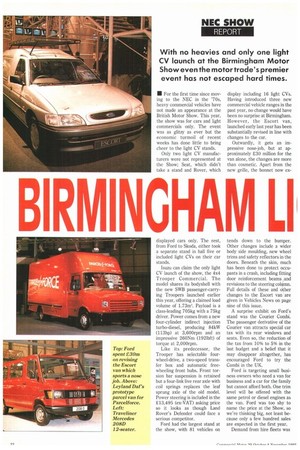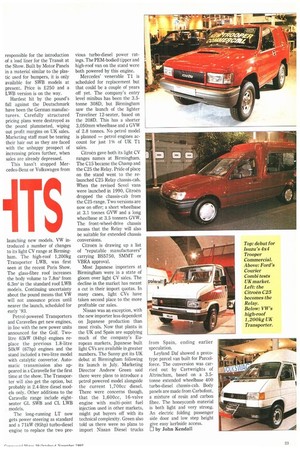BIRMINGHA M LI • For the first time since moving to
Page 24

Page 25

If you've noticed an error in this article please click here to report it so we can fix it.
the NEC in the '70s, heavy commercial vehicles have not made an appearance at the British Motor Show. This year, the show was for cars and light commercials only. The event was as glitzy as ever but the economic turmoil of recent weeks has done little to bring cheer to the light CV stands.
Only two light CV manufacturers were not represented at the Show; Seat, which didn't take a stand and Rover, which displayed cars only. The rest, from Ford to Skoda, either took a separate stand in hall five or included light CVs on their car stands,
Isuzu can claim the only light CV launch of the show, the 4x4 Trooper Commercial. The model shares its bodyshell with the new SWB passenger-carrying Troopers launched earlier this year, offering a claimed load volume of 1.73m3. Payload is a class-leading 705kg with a 75kg driver. Power comes from a new four-cylinder indirect injection turbo-diesel, producing 84kW (113hp) at 3,600rpm and an impressive 260Nm (192Ibft) of torque at 2,000rpm,
Like its predecessor, the Trooper has selectable fourwheel-drive, a two-speed transfer box and automatic freewheeling front hubs. Front torsion bar suspension is retained but a four-link live rear axle with coil springs replaces the leaf sprung axle of the old model. Power steering is included in the £13,495 (ex-VAT) asking price so it looks as though Land Rover's Defender could face a serious competitor.
Ford had the largest stand at the show, with 81 vehicles on display including 16 light CVs. Having introduced three new commercial vehicle ranges in the past year, no change would have been no surprise at Birmingham. However, the Escort van, launched early last year has been substantially revised in line with changes to the car.
Outwardly, it gets an impressive nose-job, but at approximately £30 million for the van alone, the changes are more than cosmetic. Apart from the new grille, the bonnet now ex tends down to the bumper. Other changes include a wider body side moulding, new wheel trims and safety reflectors in the doors. Beneath the skin, much has been done to protect occupants in a crash, including fitting door reinforcement beams and revisions to the steering cohlmn. Full details of these and other changes to the Escort van are given in Vehicles News on page nine of this issue.
A surprise exhibit on Ford's stand was the Courier Combi. The passenger derivative of the Courier van attracts special car tax with its rear windows and seats. Even so, the reduction of the tax from 10% to 5% in the last budget and a belief that it may disappear altogether, has encouraged Ford to try the Combi in the UK.
Ford is targeting small business owners who need a van for business and a car for the family but cannot afford both. One trim level will be offered with the same petrol or diesel engines as the van. Ford was too shy to name the price at the Show, so we're thinking big, not least because only a few hundred sales are expected in the first year Demand from hire fleets was responsible for the introduction of a load liner for the Transit at the Show. Built by Motor Panels in a material similar to the plastic used for bumpers, it is only available for SWB models at present. Price is £250 and a LWB version is on the way.
Hardest hit by the pound's fall against the Deutschmark have been the German manufacturers. Carefully structured pricing plans were destroyed as the pound plummeted, wiping out profit margins on UK sales. Marketing staff must be tearing their hair out as they are faced with the unhappy prospect of increasing prices further, when sales are already depressed.
This hasn't stopped Mercedes-Benz or Volkswagen from
launching new models. VW introduced a number of changes to its light CV range at Birmingham. The high-roof 1,200kg Transporter LWB, was first seen at the recent Paris Show. The glass-fibre roof increases the body volume to 7.8m" from 6.3m3 in the standard roof LWB models. Continuing uncertainty about the pound means that VW will not announce prices until nearer the launch, scheduled for early '93.
Petrol-powered Transporters and Caravelles get new engines, in line with the new power units announced for the Golf. Twolitre 63kW (84hp) engines replace the previous 1.8-litre 50kW (67hp) engines and the stand included a two-litre model with catalytic convertor. Automatic transmission also appeared in a Caravelle for the first time at the show. The Transporter will also get the option, but probably in 2.4-litre diesel models only. Other additions to the Caravelle range include eightseater GL SWB and CL LWB models.
The long-running LT now gets power steering as standard and a 71kW (95hp) turbo-diesel engine to replace the two pre
vious turbo-diesel power ratings. The PEM-bodied tipper and high-roof van on the stand were both powered by this engine.
Mercedes' venerable Ti is scheduled for replacement but that could be a couple of years off yet. The company's entry level minibus has been the 3.5tonne 308D, but Birmingham saw the launch of the lighter Traveliner 12-seater, based on the 208D. This has a shorter 3,050mm wheelbase and a GVW of 2.8 tonnes. No petrol model is planned — petrol engines account for just 1% of UK Ti sales.
Citroen gave both its light CV ranges names at Birmingham. The C15 became the Champ and the C25 the Relay. Pride of place on the stand went to the relaunched C25 Relay chassis-cab. When the revised Sevel vans were launched in 1990, Citroen dropped the chassis-cab from the C25 range. Two versions are now on offer; a short wheelbase at 3.1 tonnes GVW and a long wheelbase at 3.5 tanners GVW. The front-wheel-drive chassis means that the Relay will also be suitable for extended chassis conversions.
Citroen is drawing up a list of "reputable manufacturers" carrying BS5750, SMMT or VBRA approval.
Most Japanese importers at Birmingham were in a state of gloom over light CV sales. The decline in the market has meant a cut in their import quotas. In many cases, light CVs have taken second place to the more profitable car sales.
Nissan was an exception, with the new importer less dependent on Japanese production than most rivals. Now that plants in the UK and Spain are supplying much of the company's European markets, Japanese built light CVs are available in greater numbers. The Sunny got its UK debut at Birmingham following its launch in July. Marketing Director Andrew Green said there were plans to introduce a petrol powered model alongside the current 1,700cc diesel. There were concerns though, that the 1,600cc, 16-valve engine with multi-point fuel injection used in other markets, might put buyers off with its technical complexity. Green also told us there were no plans to import Nissan Diesel trucks from Spain, ending speculation. earlier
Leyland Daf showed a prototype parcel van built for Parcelforce. The conversion was carried out by Cartwrights of Altrincham, based on a 3.5tonne extended wheelbase 400 turbo-diesel chassis-cab. Body panels are made from Carbofont, a mixture of resin and carbon fibre. The honeycomb material is both light and very strong. An electric folding passenger side door and low step height give easy kerbside access.
El by John Kendall
















































































